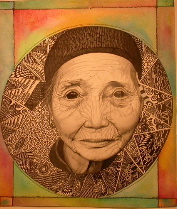
Friday night was supposed to be Cascarones night for Libby and me. But when we tried to get to Abington for the auction fundraiser organized yearly by Marta Sanchez, we were foiled by bad traffic, bad weather and non-functioning traffic lights and never made it. So we did our First Friday looking on Saturday. I went to Spartaco, Artjaz and Union 237 and got a load of color and politics, something I’m always up for.
First stop Artjaz
Kathryn Ogilvie’s work on paper — portraits annointed by repeat patterns that in some cases weave their way into the face and body of the subject — are beauties. Imbued with a kind of human-centered spirituality, the large and small works, made with watercolor, pen, pencil and collage, are icons of family. The artist’s brother — a young boy wearing a cowboy outfit — is portrayed, as are her grandmother and others who, if they’re not family must be friends. The artist’s hand is so much a part of the work the pencil marks, obsessive patterning and decoration become like caresses. (top image “Woman in a circle”)
The patterns, black and white shapes, mostly organic (eggs, eyes, whirlpools, zigzags), reminded me of African cloth or ceramics patterns. Their use in every work adds up to a kind of recurring motif bringing the family together and connecting them all to an unseeen realm of cosmic interweaving. (image right, detail of “At Peace”)
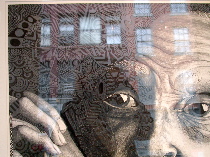
Ogilvie, who grew up in the suburbs outside Philadelphia with a Caribbean father and a European-American mother went to school at Howard (BFA, 92) and the Chicago Art Institute (MFA, 1997). While her work shows reverence for human life in general what is interesting is that this young artist is so in touch with issues of age. Time and again, the images were of grandfather or grandmotherly faces — or, in the case of “Present” an aging hand and arm. (image left)
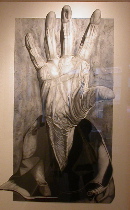
It’s beautiful work, pristine in its crisp line (although several passages of white out deflated that pristine affect in one or two cases. It might have been better just to leave the unwanted line in evidence).
Tanking up at Spartaco
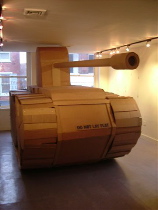
Gallery owner Terrence Laragione was working on an oil portrait of two children when I walked up the steep steps to the gallery across the street from Artjaz. Laragione, who started the gallery with his father Joseph was showing the work of two brothers, Steven and Billy Blaise Dufala. “Days on end,” is an anti-war installation that brought out the big gun in the small gallery — literally. The cardboard tank gobbled up the space but for my money, the better tanks were its little brothers, the tanks on pedestals in the corner which seemed made with boy-like love of toys and, perhaps memory of playing with G.I. Joe and all the mixed emotions that would bring back. I loved “little brother” and “not as big brother.” (top image is “Big Brother” image left is “Little Brother”)
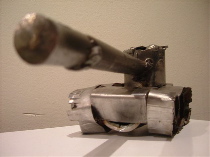
Although the peephole environment in the big cardboard tank — ink-drawn cut out figures, nudes, and a periscope, had a Piccaso-oid quality that was unexpected and nice. In fact, I could see a whole lot of peephole environments like those placed in small tanks made of cardboard and decorated to death–like Faberge eggs. Now that reverberates — in the war-as-commodity department.
The Dufala’s message seemed an overt anti-war message. It reminded me that last fall Moore College brought in Sara Beck who also brought a tank into the gallery — along with a catalog and product line conflating war and business and fashion — a different and more nuanced approach to things, less overtly anti-war and more about the culture.
Urban Renewal
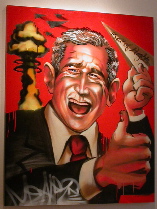
My first trip to Union 237 which opened in the fall (I’m so embarrased that I haven’t been in there) was a great one. The show upstairs has street smarts by two Los Angeles grafitti artists, Mear and Marka27, whose colorful, spray paint paintings and other work showed amazing control over a slippery medium.

Both artists have a lot on their minds, although I found Marka27’s work spoke to me more about culture and people and Mear’s work seemed hone in on graffiti culture as its subject — although there is a great political work showing Bush. (image right)
Born in Mexico, Marka27 (nee Victor M. Quinonez) was a grafitti artist in East Dallas before moving to Boston on a scholarship to the Museum School of Fine Arts. I found his work, which included a nice spray paint portrait of Miles Davis, evocative of hip hop culture, Mexican altars and religious iconography.
His altar to Che Guevara, enhanced by empty liquor bottles into which pencil portraits on paper had been inserted as the offerings/message moved me. (image left)
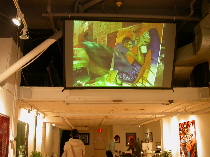
What really mesmerized however was the video projection of the two artists creating work. The piece, put together by Union 237’s production team, had music, quick action, and ended with a commercial for Marmont restaurant which, if I understood what Brian Brown, gallery director, told me, has been providing refreshments at the openings in exchange for some production work. Anyway, the video is great and worth a trip in and of itself.
Downstairs, two artists, Slope and Dave Cramske also worked the street beat. Slope, whose work I had seen previously at Asian Arts Initiative, makes use of arrows and nice color shifts to bring abstract grafitti indoors in easel sized works.
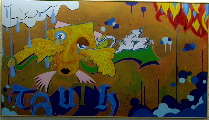
Cramske, who invents cartoon-like characters and sets them in voids of colorful space, was the more interesting and endearing artist. His characters, a combination of Elmo and Sponge Bob, made me smile. (image left)
All the gallerists I talked with said they had big turnouts Friday night, in spite of the pouring rain.









